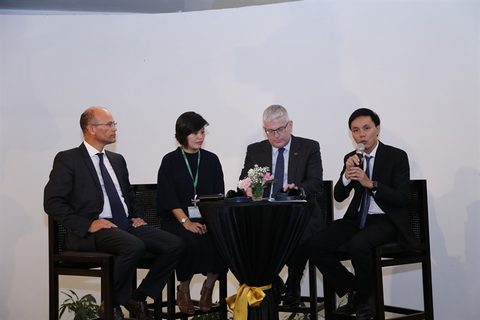Banks fail to meet businesswomen’s capital needs
 |
| Speakers discuss the women-led SMEs financing in the seminar. - VNS Photo |
The study authors urged banks to design uniquely tailored products and services for women-owned small- and medium-sized enterprises (SMEs) in order to support the under-tapped potential of this segment.
The study, by the International Finance Corporation (IFC) under the World Bank, “Women-Owned Enterprises in Viet Nam: Perceptions and Potential”, released on Thursday, said that investing in women and promoting gender equality helps businesses reach new markets and expand.
The IFC report identifies Viet Nam’s women entrepreneurs as one of the significant forces within the SME sector. Their 95,900 firms account for 21 per cent of the country’s total formal enterprises, and 42 per cent of women’s businesses are SMEs.
Running nearly 45,000 SMEs across sectors, women entrepreneurs were found to bring in average annual revenue similar to that of male entrepreneurs. Despite their strength, women entrepreneurs are less likely to access loans than their male peers.
“One of the key difficulties that women-owned businesses find is limited capital access in banks. They feel they are not taken seriously as the customer segment,” said Rubin Japhta, senior operations officer of the IFC’s Banking on Women/SME Banking division.
Speaking with the Viet Nam News on the sidelines at the seminar, Rubin said women more often find informal forms of financing. For example, they borrow from their families or take personal loans from banks and use the money for their businesses.
“This is a more expensive financing option for business,” Rubin said. “Banks need to change their services and see the women-owned SMEs as a distinct market segment. You need to think and look through what we call the gender lens.”
The financing gap is estimated at $1.2 billion for women-owned SMEs in Viet Nam. Though Viet Nam has policies to encourage women’s entrepreneurship, most banks see this segment as less profitable, higher risk and lacking in financial management skills.
The IFC’s research showed that women business owners want to borrow more to invest in their companies and they typically record higher revenue per employee and lower default rates than their male counterparts.
“Vietnamese women are great at doing business. They are more aware of risk than male counterparts which allows them to better run their businesses,” said Craig Chittick, Australian Ambassador to Viet Nam.
Vietnamese women have a large role in their families but they are very good at balancing family responsibilities and running businesses, the ambassador said. He endorsed the idea that banks should provide better services to women entrepreneurs.
Dao Gia Hung, deputy head of SME Banking of the Viet Nam Prosperity JSC Bank (VPB), said VPBank initiated its pilot women strategy one year ago and the percentage of businesswomen in its SMEs portfolio increased from 15 per cent to 25 per cent this year.
“The non-performing loan (NPL) rate among women-owned businesses is lower than among men,” Hung said, adding that he believes women are more risk-averse than men and they make payments carefully. “We see a big opportunity in the over $1 billion market of women entrepreneurs.”
On Thursday, IFC also launched the study “Tackling Childcare: The Business Case for Employer-Supported Childcare” which encourages companies to support childcare for women employees. By doing so, they can hire and retain talented women, boosting profits and productivity.
IFC has invested more than $1 billion in private-sector banks via its Banking on Women programme and has provided advisory services to banks that want to better serve the women’s market.
What the stars mean:
★ Poor ★ ★ Promising ★★★ Good ★★★★ Very good ★★★★★ Exceptional
Latest News
More News
- Gold market reform advances as SBV receives applications for bullion production (December 30, 2025 | 12:07)
- EVN and AFD sign credit agreement for Vietnam’s first pumped storage hydropower plant (December 30, 2025 | 10:06)
- Techcombank Priority Visa Signature unlocks a higher standard of living (December 29, 2025 | 16:44)
- Tax sector wraps up 2025 and sets priorities for next year (December 25, 2025 | 14:00)
- A tipping point for digital and hybrid wealth management in Vietnam (December 23, 2025 | 13:33)
- $250 million deal targets women-owned SMEs, sustainable agriculture (December 22, 2025 | 17:40)
- Stock market posts resilient 2025 performance (December 19, 2025 | 18:17)
- Citi Vietnam receives 2025 AmCham CSR recognition (December 19, 2025 | 16:35)
- As global green supply chain reshapes, will Vietnam be left behind? (December 19, 2025 | 08:00)
- Banks gear up for massive capital increases (December 18, 2025 | 17:04)

















 Mobile Version
Mobile Version